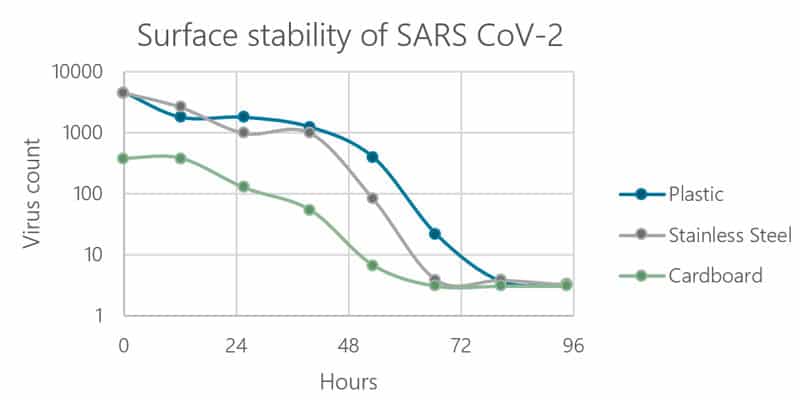As the Corona virus reaches pandemic proportions, it is crucial to implement all strategies possible to limit the spread. While the virus is part of the SARS family, it has managed to spread much more than its relatives SARS and MERS. A new study, published by 17th of March 2020, highlights the stability of the SARS CoV-2 (commonly known as the Corona virus, or Covid-19 on surfaces (up to 72 hours) and in aerosol (up to 3 hours) [1]. This underlines the need for surface disinfection, especially for plastic and stainless-steel surfaces, see the graph below.

Stability of SARS CoV-2 on surfaces. While there is a decline, it remains reasonable stable (10% remaining) for 40 hours. Graph data extracted from [1] and reformatted.
While hand sanitizers (approved grades of 60% or higher alcohol content) [2] are useful for disinfecting our hands, there is a strong alternative for disinfecting surfaces. UVC lamps has been used for disinfection for decades. When a virus infects a host or when a bacteria replicates, it uses RNA or DNA to replicate, making them grow in number and spread. The energy of UVC light interacts with DNA and RNA altering its structure so that it does not function.
Studies on various bacteria have shown that the dose required for disinfection (in this case reduction by 99.99%) for bacteria typically varies between 2 and 25 mJ/cm2 (with a few resilient strains requiring doses up to a 100 mJ/cm2). The same study shows slightly higher values in general for viruses, typically between 10 and 100 mJ/cm2 (and for adenovirus, more towards the 100-200 mJ/cm2 range).[5] For different viruses in the corona virus family, requires a dose of just under 30 mJ/cm2 on average, which seems to be the established dose to neutralize the virus of the current pandemic by 99.99% [6].

[5] Data of UV dose required for a 99.99% reduction of different microbes.
As UVC light provides a contactless method utilizing energy to disinfect a surface, it can be used efficiently on areas that are not suitable, or hard to clean with chemical surface disinfectants. UVC light is effective at reaching the recesses of a keyboard and other surfaces and objects that can be hard to clean with chemicals. It is also useful for disinfection of electronics and other items and materials that should not be exposed to liquids.
UVC light is harmful to our skin and eyes, so protective equipment such as glasses, gloves and clothing that does not expose skin should be utilized. UVC light should under no circumstances be used to clean living organisms.
Just as with sun light, the high energy of UVC light will hasten the aging of materials. The result of this aging is usually seen first after a few hundreds of hours when it comes to plastic, and even longer for other materials. After such a long exposure, the material can lose some of its flexibility and surface smoothness, becoming more fragile. Evaluation of the performance of respiratory filters shows that 120 000 mJ/cm2 is required before the structural integrity of the filter is compromised (making it more susceptible to damage), and a total of more than 950 000 mJ/cm2 before filter properties like particle penetration and flow resistance is impacted [7]. This means that a respiratory filter mask can withstand over 1000 UV light exposures at disinfection levels without losing its protective properties.
[1] N. van Doremalen et al., “Aerosol and Surface Stability of SARS-CoV-2 as Compared with SARS-CoV-1,” New England Journal of Medicine, Mar. 2020.
[2] “Coronavirus Disease 2019 (COVID-19) – Environmental Cleaning and Disinfection Recommendations”. Centers for Disease Control and Prevention. 11 February 2020.
[3] M. Eickmann et al., “Inactivation of three emerging viruses – severe acute respiratory syndrome coronavirus, Crimean–Congo haemorrhagic fever virus and Nipah virus – in platelet concentrates by ultraviolet C light and in plasma by methylene blue plus visible light,” Vox Sanguinis, Jan. 2020.
[4] W. Kowalski, Ultraviolet Germicidal Irradiation Handbook. Springer Berlin Heidelberg, 2009.
[5] Malayeri, Adel & Mohseni, Madjid & Cairns, Bill & Bolton, James. (2016). Fluence (UV Dose) Required to Achieve Incremental Log Inactivation of Bacteria, Protozoa, Viruses and Algae. IUVA News. 18. 4-6.
[6] Kowalski, Wladyslaw & Walsh, Thomas & Petraitis, Vidmantas. (2020). 2020 COVID-19 Coronavirus Ultraviolet Susceptibility.
[7] W. G. Lindsley et al., “Effects of Ultraviolet Germicidal Irradiation (UVGI) on N95 Respirator Filtration Performance and Structural Integrity,” Journal of Occupational and Environmental Hygiene, vol. 12, no. 8, pp. 509–517, Jul. 2015.

| Cookie | Duration | Description |
|---|---|---|
| cookielawinfo-checbox-analytics | 11 months | This cookie is set by GDPR Cookie Consent plugin. The cookie is used to store the user consent for the cookies in the category "Analytics". |
| cookielawinfo-checbox-functional | 11 months | The cookie is set by GDPR cookie consent to record the user consent for the cookies in the category "Functional". |
| cookielawinfo-checbox-others | 11 months | This cookie is set by GDPR Cookie Consent plugin. The cookie is used to store the user consent for the cookies in the category "Other. |
| cookielawinfo-checkbox-necessary | 11 months | This cookie is set by GDPR Cookie Consent plugin. The cookies is used to store the user consent for the cookies in the category "Necessary". |
| cookielawinfo-checkbox-performance | 11 months | This cookie is set by GDPR Cookie Consent plugin. The cookie is used to store the user consent for the cookies in the category "Performance". |
| viewed_cookie_policy | 11 months | The cookie is set by the GDPR Cookie Consent plugin and is used to store whether or not user has consented to the use of cookies. It does not store any personal data. |